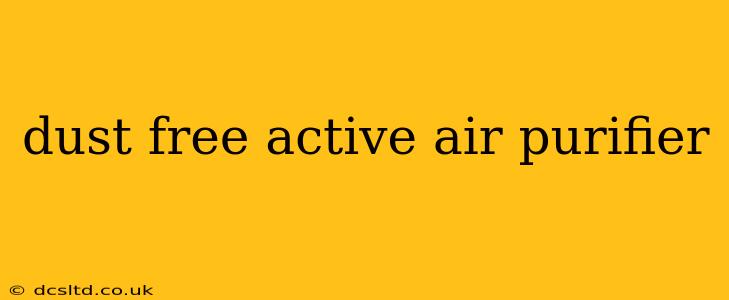Are you tired of battling dust and allergens in your home? Do you crave that feeling of truly clean, fresh air? Then you're in the right place. This comprehensive guide explores the world of active air purifiers, focusing on their effectiveness in creating a dust-free environment. We'll delve into the technology behind these powerful devices, address common questions, and help you choose the best purifier for your needs.
What is an Active Air Purifier?
Active air purifiers, unlike passive methods like simply opening a window, actively work to remove pollutants from the air. They employ various technologies to capture dust, pollen, pet dander, mold spores, and other airborne particles. This makes them a particularly effective solution for those with allergies, asthma, or sensitivities to dust. The "active" aspect highlights their proactive approach to cleaning the air, rather than relying on passive ventilation.
How Effective Are Active Air Purifiers at Removing Dust?
Active air purifiers are highly effective at removing dust, depending on the type and quality of the purifier. The most effective models use a combination of filtration methods, such as HEPA filters (High-Efficiency Particulate Air filters), which trap particles as small as 0.3 microns with 99.97% efficiency. Some advanced models also incorporate UV-C lights to kill bacteria and viruses, further enhancing their ability to create a dust-free environment. The effectiveness is also influenced by factors such as room size and the amount of dust present. Larger rooms naturally require more powerful purifiers, and regular cleaning or replacement of filters is essential to maintain optimal performance.
What are the Different Types of Active Air Purifiers?
Several types of active air purifiers exist, each employing different technologies:
- HEPA Filter Purifiers: These are the most common and generally the most effective for removing dust. HEPA filters are the gold standard in air purification.
- Electrostatic Precipitators (ESPs): ESPs use an electric charge to attract and trap dust particles. While effective, they may not capture smaller particles as efficiently as HEPA filters.
- Ionic Air Purifiers: These generate ions that attach to dust particles, causing them to clump together and fall to the ground. However, the effectiveness of ionic purifiers against dust is often less than HEPA filters.
- Combination Systems: Many high-end models combine HEPA filtration with other technologies like UV-C light or activated carbon filters for enhanced performance. These systems often provide the best results in removing dust and other pollutants.
What is the Best Active Air Purifier for Dust Allergies?
The best active air purifier for dust allergies will depend on your specific needs and the size of the room. Consider the following factors:
- Room size: Choose a purifier with a sufficient Clean Air Delivery Rate (CADR) for the size of the room. CADR indicates how much clean air a purifier can deliver per minute.
- Filter type: A HEPA filter is crucial for effectively removing dust. Look for purifiers with true HEPA filters, not just "HEPA-like" filters.
- Additional features: Features like UV-C sterilization, activated carbon filters (for odor removal), and smart home integration can add value depending on your preferences.
- Noise level: Some purifiers can be quite noisy. Check reviews for information about noise levels if this is a concern.
How Often Should I Change the Filters in My Active Air Purifier?
Filter replacement frequency depends on the purifier model, the air quality in your home, and how often you use the purifier. However, it is generally recommended to replace HEPA filters every 6-12 months, and possibly sooner if you live in a particularly dusty environment or use the purifier frequently. Always check the manufacturer's recommendations for your specific model. Regular filter replacement is crucial for maintaining the purifier's effectiveness.
Can Active Air Purifiers Remove All Dust?
While active air purifiers are extremely effective at removing a significant portion of dust, they cannot completely eliminate every single particle. Regular cleaning of your home, including dusting and vacuuming, is still essential for a truly dust-free environment. Think of the purifier as a crucial part of a holistic approach to clean air, not a standalone solution.
This detailed overview should provide a strong foundation for understanding and choosing the best dust-free active air purifier for your home. Remember to always consider factors like room size, filter type, and additional features to ensure you select a purifier that meets your specific needs and enhances your indoor air quality.
